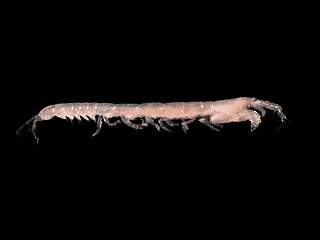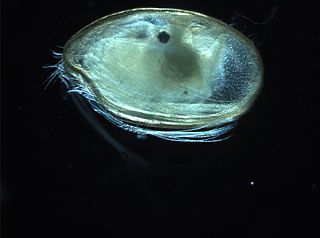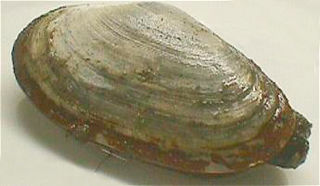
Ostracods, or ostracodes, are a class of the Crustacea, sometimes known as seed shrimp. Some 70,000 species have been identified, grouped into several orders. They are small crustaceans, typically around 1 mm (0.04 in) in size, but varying from 0.2 to 30 mm in the case of Gigantocypris. Their bodies are flattened from side to side and protected by a bivalve-like valve or "shell" made of chitin, calcium carbonate and protein. The hinge of the two valves is in the upper (dorsal) region of the body. Ostracods are grouped together based on gross morphology. While early work indicated the group may not be monophyletic and early molecular phylogeny was ambiguous on this front, recent combined analyses of molecular and morphological data found support for monophyly in analyses with broadest taxon sampling.
Orthogastropoda was a major taxonomic grouping of snails and slugs, an extremely large subclass within the huge class Gastropoda according to the older taxonomy of the Gastropoda.

The crustacean order Tanaidacea make up a minor group within the class Malacostraca. There are about 940 species in this order.

The Myodocopida is one of the two orders within the Myodocopa, in turn a subclass of the Ostracoda. The Myodocopida are distinguished by a worm-like seventh limb, and, usually, a rostrum above an incisure (notch) from which the antennae can protrude. Unlike other ostracods, many species of the Myodocopida have lateral compound eyes Over the last thirty years there has been much research into the morphology, behaviour and distribution of myodocopids. More recently, DNA sequences have been used to investigate the phylogeny of various groups.

Cylindroleberididae is a family of ostracods that shows remarkable morphological diversity. The defining feature is the possession of gills: 7–8 leaf-like pairs at the posterior of the body. Other features common to all species in the family include a "baleen-comb" on both the maxilla and the fifth limb, a sword-shaped coxal endite on the mandible, and the triaenid bristles on the basal endites of the mandible.

Heteroconchia is a taxonomic infraclass of saltwater clams, marine bivalve molluscs, belonging to the subclass Autobranchia

Octopodiformes is a superorder of the subclass Coleoidea, comprising the octopuses and the vampire squid. All living members of Octopodiformes have eight arms, either lacking the two tentacles of squid or modifying the tentacles into thin filaments. Octopodiformes is often considered the crown group of octopuses and vampire squids, including all descendants of their common ancestor. Some authors use the term Vampyropoda for the same general category, though others use "Vampyropoda" to refer to the total group. Another term is Octobranchia, referring to cephalopods without prominent tentacles.

Myida is an order of saltwater and freshwater clams, marine and freshwater bivalve molluscs in the subclass Heterodonta. The order includes such bivalves as soft-shell clams, geoducks and shipworms.
The Podocopida are an order of ostracods in the subclass Podocopa. It is the most diverse of the four orders of ostracods, and also has a rich fossil record.
Polycopidae is a family of marine ostracods. Its members are related to animals in the suborder Halocypridina, but are sufficiently distinct to be placed in the sub-order Cladocopina. There is even some speculation that a separate order may be warranted. The genera in the family differ from the other suborder, Halocypridina, in several features: the central adductor muscle scars are in a triangular or half-rosette pattern, they lack sixth and seventh limbs, and the maxilla has both an exopod and endopod.
Polycopidae is a superfamily of marine ostracods. It is the only superfamily in the suborder Cladocopina.
Krausella is an extinct genus of ostracods. It is the sole genus in family Krausellidae.
The taxonomy of the Gastropoda, as revised by Winston Ponder and David R. Lindberg in 1997, is an older taxonomy of the class Gastropoda, the class of molluscs consisting of all snails and slugs. The full name of the work in which this taxonomy was published is Towards a phylogeny of gastropod molluscs: an analysis using morphological characters.
Cytherellidae is a family of ostracods, Eyes are absent. It contains 11 genera:

Cyprididae is "the most diverse group of freshwater ostracods". It contains over 1000 species, which represents 50% of the known species of freshwater ostracods. Around 60% of genera in the family are endemic to a single zoogeographic region. The family contains 16 subfamilies, and is most diverse in the Afrotropical realm, with over 300 species in 45 genera. Many Cyprididae occur in temporary water bodies and have drought-resistant eggs, mixed/parthenogenetic reproduction and ability to swim. These biological attributes pre-adapt them to form successful radiations in these habitats. Bennelongia is an interesting of the family Cyprididae. It may be the last true descendant of the Mesozoic lineage of Cypridea, which was a dominant lineage of ostracod in non-marine waters in the Cretaceous.

Candonidae is a family of ostracods, containing around 25% of all known species of freshwater ostracods. Around 75% of genera in the family are endemic to a single zoogeographic region. It contains more than 500 species, of which more than 300 are endemic to the Palearctic realm.
The biological systematics and taxonomy of invertebrates as proposed by Richard C. Brusca and Gary J. Brusca in 2003 is a system of classification of invertebrates, as a way to classify animals without backbones.
Palaeocopida is an order of ostracods in the subclass Podocopa. Most species in the suborder are extinct, and only the genera Manawa and Puncia in the family Punciidae are extant.

Amphissites is an extinct genus of ostracod belonging to the suborder Beyrichicopina and family Amphissitinae. Species belonging to the genus lived from the Devonian to the Permian in Europe, North America, Australia, and east Asia. The genus were likely deposit-feeders, and may have survived briefly into the Triassic.









